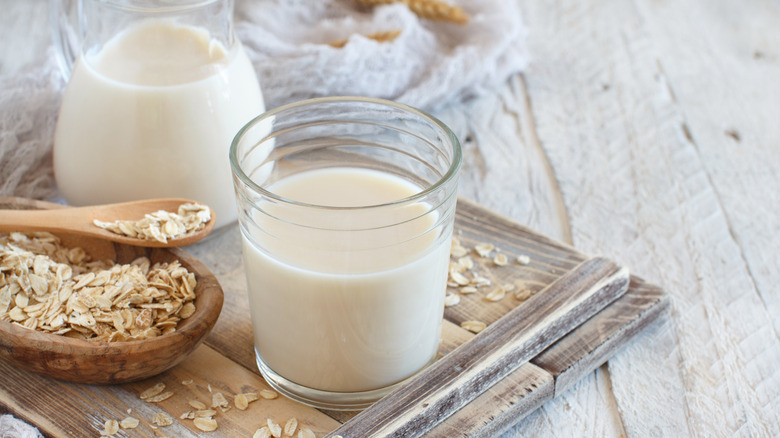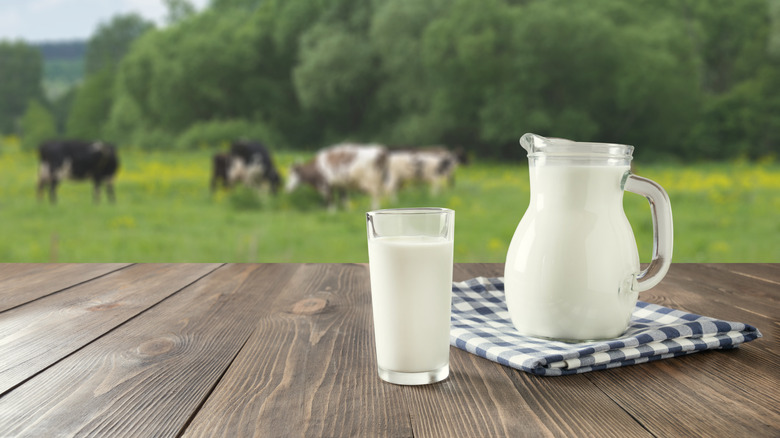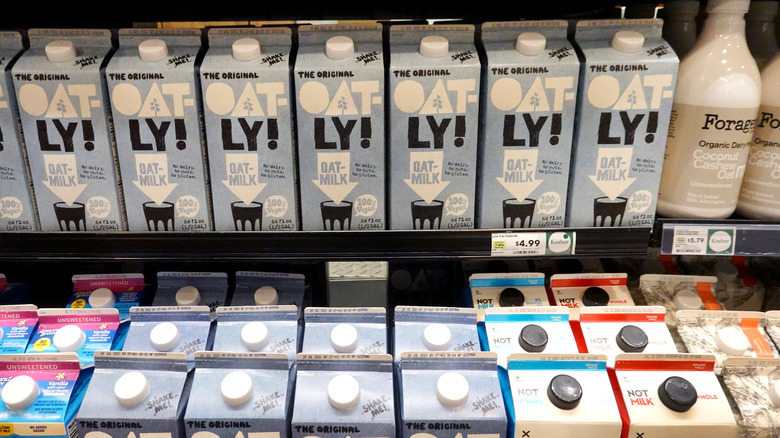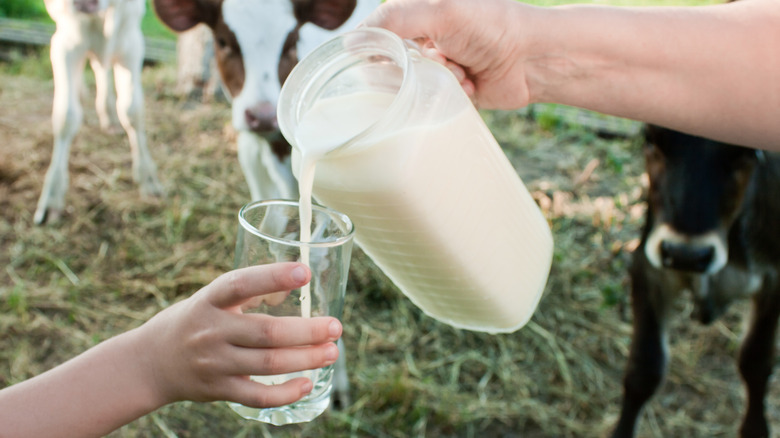Oat Milk Vs Dairy Milk: What's The Difference?
Walk into any cafe and you may see as many options that use oat milk as you will traditional cow's milk. By now, it's undeniable that the non-dairy alternative is on the rise. As an increasingly common milk substitute, oat milk even has the data to back up its popularity. Sales for oat milk saw a significant year-to-year increase and rose by more than 50% from 2021 to 2022 (per Food Navigator-USA). Although oat milk continues to trail behind almond milk, it's clearly on the up and up.
Part of oat milk's popularity may have something to do with its environmental impact. Non-dairy milk alternatives are routinely touted as more sustainable than cow's milk, though almond milk's water inefficiency leaves room for improvement. So while oat milk is clearly rising in the ranks, the question remains: How does oat milk stack up against traditional cow's milk? Understanding how the two compare is a matter of knowing how they're made, as well as their respective nutritional benefits.
Dairy milk originates — perhaps obviously — from cows
If you really want to know what goes into traditional cow's milk, head to the source. Farm cows are responsible for the milk that has traditionally complemented your cereal, lightened your coffee, and bound together your baked goods. The process in which cows give milk, however, is more complicated than picking up a carton from the store.
According to organic milk brand Organic Valley, milking a cow takes roughly ten minutes. The process begins by leading cows to a stall and attaching them to a milking unit. Once the apparatus retrieves the milk, the liquid is cooled and stored until a milk truck arrives. U.S. farm milk in 2021 was roughly 87 percent water, 4 percent milk fat, and 9 percent skim solids (via the U.S. Department of Agriculture's Economic Research Service).
Before it's ready for general consumption, milk must undergo a rigorous process; per Organic Valley, milk faces 57 quality checkpoints before it reaches the shelves. This includes pasteurization (per U.S. Dairy). Processing the milk creates the drink that we buy from stores.
Oat milk undergoes its own milking process ... sans cows
To make oat milk, all you really need are oats and water (though a little sweetener doesn't hurt). Oat milk is, essentially, a milk-like beverage made from oats, and it's produced exactly as its name suggests. According to Women's Health Magazine, making oat milk is straightforward: Simply blend oats and water together and strain to create a consistent and smooth liquid. From there, you can add vitamins, minerals, or sweeteners — anything to amplify your milk so it tastes according to your liking.
Unlike cow's milk, you don't need an entire farm set-up to make oat milk from home. While it's easy to pick up a carton from the store, it's just as easy to throw your own together. At home, you can control what goes into your milk, limiting sweeteners, as well as artificial flavors. At-home oat milk makers should be warned, however, that the homemade version tends to be on the slimy side due to the breakdown of oat starches. To reduce this possibility, don't soak your oats prior to blending and be careful not to overblend (via Bon Appetit).
Oat milk is less nutritious than it appears, though it remains a great option for vegans
Contrary to marketing messages and sustainability benefits, oat milk is less nutritious than it sounds, thanks to the addition of emulsifiers, stabilizers, and sweeteners. For example, oat milk from non-dairy milk brand Silk contains a combination of filtered water and oat concentrate as well as less than 2% of sunflower oil, vitamin and mineral blend, dipotassium phosphate, sea salt, gellan gum, locust bean gums, and ascorbic acid, among others. Good Housekeeping, therefore, recommends checking the label of your oat milk options before purchasing a carton. Although oats contain all kinds of valuable nutrients, it's also unclear whether oat milk retains the benefits of the oats themselves.
More clear, however, is oat milk's fortification. According to Gonna Need Milk, the nutrients in oat milk are incorporated during manufacturing rather than natural processes, so they reduce the non-dairy alternative's nutritional and natural composition. Despite these less-than-nutritious additions to oat milk, the substitute remains a better option than whole milk. Per Today, oat milk is also slightly less caloric than whole dairy milk, containing roughly 30 fewer calories than whole cow's milk.
Dairy milk contains more natural nutrients than oat milk
In total, dairy milk provides roughly 13 nutrients, including calcium and protein, and other vitamins (per The American Dairy Association). These nutrients have an assortment of benefits, though not all are natural. For example, according to US Dairy, vitamin D is fortified in dairy milk, meaning it's not naturally occurring in the milk's composition.
While many of dairy milk's other nutrients are natural, some benefits remain unclear. Per the Harvard School of Public Health, cow's milk has been marketed as good for the bones, though research has yet to show the correlation between bone health and milk consumption. As such, the pros and cons of whole dairy and oat milks are multi-faceted. Both are worth consuming in moderation, though Julie Holbrook, MS, RDN, LDN, and outpatient dietitian at Northwestern Medicine put it best: "Many people think plant-based milk alternatives like oat milk are a healthier option than cow's milk," Holbrook told Northwestern Medicine, succinctly summarizing the relationship between the two milks. "This is not always the case. There are pros and cons to both based on your nutritional needs and personal preferences."



